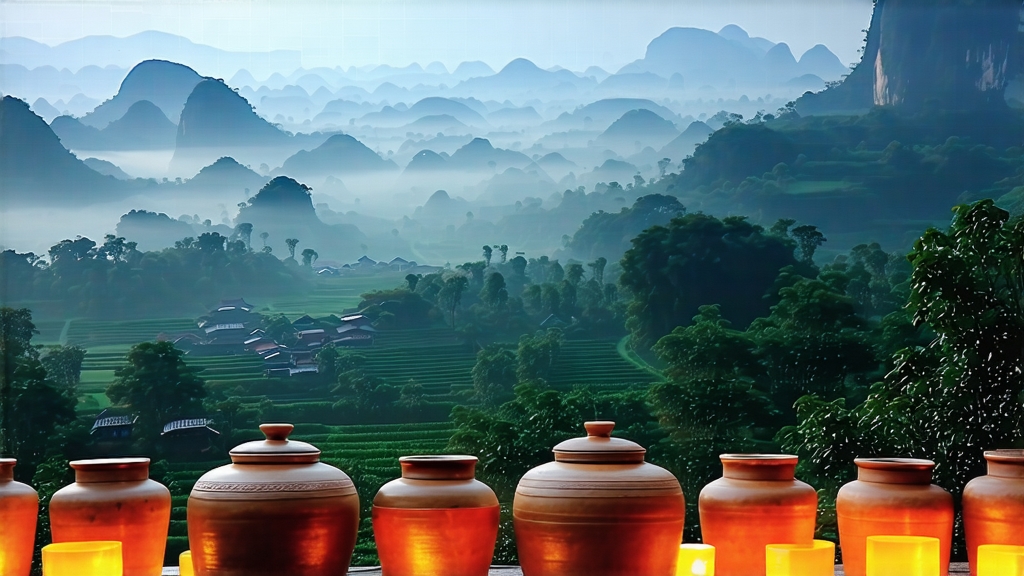
Tucked away in the humid, bamboo-covered hills of southern China’s Guangxi Zhuang Autonomous Region, Liu Bao tea has spent four centuries quietly perfecting the art of graceful aging. While Pu-erh hogs the limelight, Liu Bao—literally “Six Forts”—is the connoisseur’s whispered secret: a dark tea that carries the mineral breath of limestone gullies, the sweetness of longan fruit, and the earthy nostalgia of old Chinese medicine shops. To understand Liu Bao is to listen to a story told in micro-organisms, river mist, and time.
History: From Border Garrison to Maritime Currency
The name Liu Bao refers to the six historical fortresses that once protected tea caravans moving between the Qing empire and the southern trade routes. During the late Ming dynasty (17th c.), pressed tea leaves from these forts accompanied mule teams to Guangzhou, then sailed aboard Chinese junks bound for Southeast Asia. In the bustling ports of Malacca and Singapore, Liu Bao became a hard currency: coolies were paid partly in tea bricks because the leaf aided digestion of a rice-heavy diet and resisted spoilage in tropical holds. By the 19th century, entire warehouses in Kuala Lumpur stacked nothing but Liu Bao baskets, their interiors tattooed with the soot of joss-stick smoke and sea salt. The British, ever alert to profit, re-exported the tea to Calcutta and London where it was marketed as “China Slimming Leaf,” an early wellness fad.
Terroir: Where Rivers Breathe through Stone
Guangxi’s Wuzhou prefecture sits on a karst landscape riddled with subterranean rivers. Day-night temperature swings of 15 °C force the tea bushes—predominantly a large-leaf varietal related to Camellia sinensis var. assamica—to develop thick, pectin-rich leaves. The humidity hovers above 80 % most of the year, creating a natural incubator for the yeasts and molds that will later steer fermentation. Locals insist the water itself is a co-artisan: drawn from mountain springs rich in calcium and magnesium, it softens the leaf’s tannins and gifts Liu Bao its signature slippery mouthfeel known as “mountain grease.”
Craft: The Secret Life of Wet-Piling
Unlike Pu-erh, Liu Bao undergoes a Guangxi-specific version of wet-piling (wo dui) that is shorter yet hotter. Fresh leaves are pan-fired at 280 °C for eight minutes to kill green enzymes, then rolled on bamboo trays until the edges bruise and exhale a faint orchid scent. After sun-drying, the maocha is sprayed with Wuzhou spring water—never distilled—and piled 70 cm deep inside spotless cement chambers. The pile is covered with jute sacks and left to ferment for 25–35 days, its core temperature carefully kept between 55 and 60 °C by turning every three days. A local mold, Aspergillus niger LZ-1, dominates this stage, converting catechins into theaflavins and producing a unique compound called 6-n-propyl-6H-benzo[1,3]oxathin-2-one, which translates into Liu Bao’s trademark betel-nut aroma. Once the pile cools, the tea is steamed, pressed into 40 kg wicker baskets lined with banana leaf, and transferred to humid underground caves for slow aging that can last decades.
Aging Architecture: Bamboo, Leaf, and Air
The traditional basket (lóng) is not mere packaging; it is a breathing fermentation vessel. Over years, the banana leaf desiccates, creating micro-gaps that allow oxygen to coax further oxidation while the rattan imprints its grassy lignin notes onto the leaf cake. Tea merchants stack baskets seven meters high in cave warehouses where the relative humidity is a constant 88 %. Every midsummer, workers rotate the stacks so that each basket spends one season closer to the cave mouth, absorbing the floral breeze of night-blooming jasmine that drifts in from surrounding villages. A 30-year Liu Bao acquires a ruby-black liquor and a scent reminiscent of antique sandalwood chests filled with dried longan and camphor.
Tasting Lexicon: How to Read the Dark Scroll
Begin with dry leaf aromatics: break off 5 g from the basket’s edge and warm it in a pre-heated gaiwan. A young (3-year) Liu Bao smells of rain-soaked